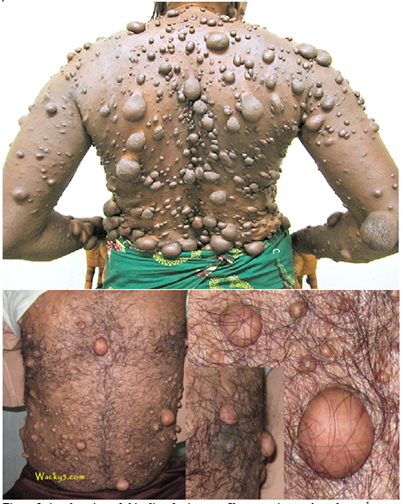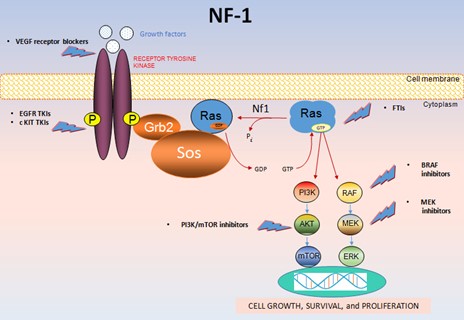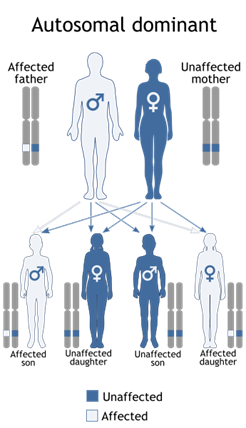Review Article
The Role of Mutations on Gene NF1 in Neurofibromatosis type 1 Syndrome
Division of Medical Genetics and Molecular Pathology Research, Harvard University, Boston Children's Hospital, USA.
*Corresponding Author: Shahin Asadi, Division of Medical Genetics and Molecular Pathology Research, Harvard University, Boston Children's Hospital, USA.
Citation: Shahin Asadi. (2022). The Role of Mutations on Gene NF1 in Neurofibromatosis type 1 Syndrome. Journal of Neuroscience and Neurological Research. 1(1); DOI: https://www.doi.org/brs/2022/jnnr/0003
Copyright: © 2022 Shahin Asadi, this is an open-access article distributed under the terms of the Creative Commons Attribution License, which permits unrestricted use, distribution, and reproduction in any medium, provided the original author and source are credited.
Received: September 04, 2022 | Accepted: October 04, 2022 | Published: October 10, 2022
Abstract
Neurofibromatosis syndrome type 1 is a genetic disorder characterized by skin discoloration (pigmentation) and tumor growth along nerves in the skin, brain, and other parts of the body. Almost all people with neurofibromatosis type 1 in early childhood have smooth brown spots on different parts of the skin. These spots also grow with age and are more common in the armpits and groin. Neurofibromatosis syndrome type 1 is caused by a mutation in the NF1 gene, which is located in the long arm of chromosome 17 as 17q11.2.
Keywords: neurofibromatosis syndrome type 1; nf1 gene; genetic mutations; skin disorder
Introduction
Generalities of neurofibromatosis Type 1 Syndrome
Neurofibromatosis syndrome type 1 is a genetic disorder characterized by skin discoloration (pigmentation) and tumor growth along nerves in the skin, brain, and other parts of the body. The signs and symptoms of this syndrome vary widely among affected people [1].
Figure 1: Images of skin disorders in patients with type 1 neurofibromatosis syndrome.
Clinical signs and symptoms of neurofibromatosis type 1 syndrome
Almost all people with neurofibromatosis type 1 in early childhood have smooth brown spots on different parts of the skin. These spots also grow with age and are more common in the armpits and groin. Most adult neurofibromatosis is type 1 neurofibromas, which are benign tumors that are usually located under the skin. These tumors may also develop in nerves near the spinal cord or along nerves elsewhere in the body [1,2].
Figure 2: Another view of skin disorder in neurofibromatosis type 1 syndrome.
Some people with type 1 neurofibromatosis develop cancerous tumors that grow along the nerves. These tumors, which usually develop in adolescence or adulthood, are called malignant peripheral nerve sheath tumors. In addition, people with type 1 neurofibromatosis have an increased risk of other cancers, including brain tumors and leukemia [1,3].
In childhood, patients with neurofibromatosis type 1, benign growths called leach nodules often appear in the colored part of the eye (iris) that do not interfere with vision. Some people develop tumors that grow along the nerve from the eye to the brain (optic nerve). These tumors, called optic gliomas, can lead to vision loss or complete loss of vision. It should be noted that in some cases, optic gliomas have no effect on vision [1,4].
Figure 3: Images of ocular and skin disorders in patients with neurofibromatosis type 1 syndrome.
Other signs and symptoms of neurofibromatosis type 1 syndrome include high blood pressure, short stature, abnormally large head size (macrocephaly), and skeletal disorders such as abnormal curvature of the spine (scoliosis). Although many people with type 1 neurofibromatosis have normal intelligence, learning disabilities (ADHD) are more common in people with the syndrome [1,5].
Etiology of neurofibromatosis type 1 syndrome
Neurofibromatosis syndrome type 1 is caused by a mutation in the NF1 gene, which is located in the long arm of chromosome 17 as 17q11.2. This gene provides the instructions for the synthesis of a protein called neurofibromin. This protein is produced in many cells, including nerve cells and specific cells around nerves (oligodendrocytes and Schwann cells). The neurofibromin protein acts as a tumor suppressor, meaning it controls cells from overgrowth and division [1,6].
Figure 4: Schematic view of chromosome 17 where the NF1 gene is located in the long arm of this chromosome as 17q11.2.
Mutations in the NF1 gene lead to the production of an inactive copy of the neurofibromin protein that cannot regulate cell growth and division. As a result, tumors called neurofibromas can form along nerves throughout the body. It is not yet clear how mutations in the NF1 gene lead to features of neurofibromatosis syndrome type 1, such as brown spots on the skin and learning disabilities [1,7].
Neurofibromatosis type 1 syndrome follows an autosomal dominant genetic pattern. Therefore, a copy of the NF1 mutant gene (either parent) is required to cause the syndrome, and the chance of having a child with the autosomal dominant syndrome is 50% for each possible pregnancy. Half of cases of neurofibromatosis syndrome type 1 are caused by new gene mutations without a family history. Unlike autosomal dominant inheritance pattern conditions, which require one copy of a mutated gene to cause disease, two copies of the NF1 mutant gene are required to cause a tumor in neurofibromatosis type 1. In other words, all people who are born with an NF1 mutant gene make a mutation in the second version of the same gene in specialized cells around the nerves during their lifetime, which means that the second version of the NF1 gene develops as people with the syndrome age. It mutates and develops tumors characteristic of type 1 neurofibromatosis [1,8].
Frequency of neurofibromatosis type 1 syndrome
Neurofibromatosis syndrome type 1 is an almost common genetic disorder with a prevalence of about 1 in 3,000 to 1 in 4,000 worldwide [1,9].
Figure 5: Schematic of the molecular pathway of the NF1 gene with its mechanism of action in the cytoplasm.
Diagnosis of Neurofibromatosis Type 1 Syndrome
Neurofibromatosis syndrome type 1 is diagnosed based on clinical findings and some pathological tests. The most accurate way to diagnose this syndrome is a molecular genetic test for the NF1 gene to check for possible mutations [1,10].
Figure 6: Schematic of the dominant autosomal inherited pattern that neurofibromatosis syndrome type 1 also follows.
Treatment routes of neurofibromatosis type 1 syndrome
The treatment and management strategy for neurofibromatosis type 1 syndrome is symptomatic and supportive. Treatment may be done with the help and coordination of a team of specialists including a neurologist, brain surgeon, hematologist, oncologist and cancer geneticist, orthopedist and orthopedist, ophthalmologist and other health care professionals. There is no definitive treatment for this syndrome and all clinical measures are to reduce the suffering of patients. Genetic counseling is also essential for all parents who want a healthy baby [1,11].
Figure 7: Schematic of the signs and symptoms of neurofibromatosis type 1 syndrome.
Discussion and Conclusion
Most adult neurofibromatosis is type 1 neurofibromas, which are benign tumors that are usually located under the skin. Mutations in the NF1 gene lead to the production of an inactive copy of the neurofibromin protein that cannot regulate cell growth and division. Neurofibromatosis type 1 syndrome follows an autosomal dominant genetic pattern. Therefore, a copy of the NF1 mutant gene (either parent) is required to cause the syndrome, and the chance of having a child with the autosomal dominant syndrome is 50% for each possible pregnancy. Treatment may be done with the help and coordination of a team of specialists including a neurologist, brain surgeon, hematologist, oncologist and cancer geneticist, orthopedist and orthopedist, ophthalmologist and other health care professionals [1,12,13].
References
- Asadi S. (2018). Pathology in Medical Genetics Book, Vol 8, Amidi Publications, Iran.
Publisher | Google Scholor - Baralle D, Mattocks C, Kalidas K, Elmslie F, Whittaker J, Lees M, Ragge N, Patton MA, Winter RM, ffrench-Constant C. (2003). Different mutations in the NF1 gene are associated with Neurofibromatosis-Noonan syndrome (NFNS). Am J Med Genet A. 119A(1):1-8.
Publisher | Google Scholor - De Luca A, Bottillo I, Sarkozy A, Carta C, Neri C, Bellacchio E, Schirinzi A, Conti E, Zampino G, Battaglia A, Majore S, Rinaldi MM, Carella M, Marino B, Pizzuti A, Digilio MC, Tartaglia M, Dallapiccola B. (2005). NF1 gene mutations represent the major molecular event underlying neurofibromatosis-Noonan syndrome. Am J Hum Genet. 77(6):1092-1101.
Publisher | Google Scholor - Friedman JM. Neurofibromatosis. In: Pagon RA, Adam MP, Ardinger HH, Wallace SE, Amemiya A, Bean LJH, Bird TD, Ledbetter N, Mefford HC, Smith RJH, Stephens K, editors. GeneReviews®. Seattle (WA): University of Washington, Seattle; 1993-2017.
Publisher | Google Scholor - Hart L. (2005). Primary care for patients with neurofibromatosis 1. Nurse Pract. 2005 Jun;30(6):38-43. Review. Erratum in: Nurse Pract. 30(7):4.
Publisher | Google Scholor - Hüffmeier U, Zenker M, Hoyer J, Fahsold R, Rauch A. (2006). A variable combination of features of Noonan syndrome and neurofibromatosis type I are caused by mutations in the NF1 gene. Am J Med Genet A. 140(24):2749-2756.
Publisher | Google Scholor - Kandt RS. (2003). Tuberous sclerosis complex and neurofibromatosis type 1: the two most common neurocutaneous diseases. Neurol Clin. 21(4):983-1004.
Publisher | Google Scholor - Levine TM, Materek A, Abel J, O'Donnell M, Cutting LE. (2006). Cognitive profile of neurofibromatosis type 1. Semin Pediatr Neurol. 13(1):8-20.
Publisher | Google Scholor - Reynolds RM, Browning GG, Nawroz I, Campbell IW. (2003). Von Recklinghausen's neurofibromatosis: neurofibromatosis type 1. Lancet. 361(9368):1552-1554.
Publisher | Google Scholor - Rose VM. (2004). Neurocutaneous syndromes. Mo Med. 101(2):112-116.
Publisher | Google Scholor - Theos A, Korf BR; American College of Physicians; American Physiological Society. (2006). Pathophysiology of neurofibromatosis type 1. Ann Intern Med. 144(11):842-849.
Publisher | Google Scholor - Tonsgard JH. (2006). Clinical manifestations and management of neurofibromatosis type 1. Semin Pediatr Neurol. 13(1):2-7.
Publisher | Google Scholor - Ward BA, Gutmann DH. (2005). Neurofibromatosis 1: from lab bench to clinic. Pediatr Neurol. 32(4):221-228.
Publisher | Google Scholor





















